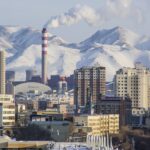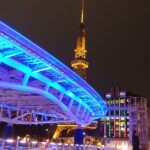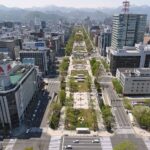Kobe, Japan is a bustling metropolis with several public transit choices for locals and tourists alike. Buses, trains, ferries, and cable cars comprise Kobe’s extensive public transportation system. The Kobe Municipal Subway serves as the city’s primary public transportation system. Buses are also widely used, and the city has many bus routes. Access to other major parts of the city is also made easy by the Kobe City Railway and Kobe Rapid Transit Railway. The neighboring islands may be reached by ferry, and a spectacular cable car ride on the Kobe Ropeway provides breathtaking panoramas of the city.
Kobe subway – Basic information
Getting around Kobe on the subway is a quick and easy option. There are 5 lines in total, serving a total of 28 stops. The lines traverse the entirety of Kobe, linking its northern, southern, eastern, and western neighborhoods. The lines are color-coded so that you can easily determine which one to take. There is an electronic ticketing system on all trains, and ticket machines can be found at most stops. In addition to the convenient metro system, getting around the city is a breeze thanks to the large network of bus routes that link to it.
The lines of the Kobe subway system
Hokushin Line – Orange
Connecting Tanigami in Kita-ku with Shin-Kobe in Ch-ku. These are the only two stops along the 7.5 km line. In 2020, the Hokushin Line, formerly run by the third-sector Hokushin Kyuko Electric Railway, was integrated into the subway system by the Kobe Municipal Transportation Bureau.
Seishin-Yamat (Midori no U-Line) – AZURE
It connects the city proper to Kobe’s eastern and western suburbs.
Kaigan Lin (Yumekamome) – Blue
Linear motors provide the propulsion for the line’s trains. In Japan, this MMRT line represents the third such project.
Port Liner – Yellow
The first Port Liner debuted on February 5, 1981, and ran for a total of 6.4 kilometers with nine stations. On February 2, 2006, the line was extended to the south to serve the brand-built Kobe Airport.
Rokko Liner – Green
On February 21st, 1990, the 4.5-kilometer Rokko Liner opened to the public.
Map of Kobe Metro 2024 – Free Download in PDF

Click and download the map of Kobe’s underground system for 2024
Kobe Metro 2024 is a fantastic, freely downloadable PDF map of the Kobe Metro system. It’s a must-have for visitors and locals alike, as it details every line and stop in Kobe’s public transportation system. Transfer details, estimated walking times, and other practical data are also included on the map. Anyone can take benefit of this wonderful tool because the PDF is easily accessible and free of charge. This map makes using the Kobe subway system a breeze.
Transportation tickets – actual prices
A single-ride ticket is the most affordable option for using Kobe’s public transportation system. These tickets are good for one ride on the bus, train, or tram and cannot be exchanged for cash. The fare ranges from 120 to 310, depending on the distance traveled. You can buy single tickets from vending machines or directly from the bus driver.
Those who intend to make frequent use of the public transportation system during their visit may consider purchasing a prepaid card. The Surutto Kansai Card is the most widely used prepaid card in Kobe since it can be used on all forms of public transportation. The card’s balance can be reloaded at vending machines or convenience stores, and fares are withdrawn from the card automatically.
Another well-liked Kobe attraction is the Kobe City Bus Tour Card. For a flat charge of 600 yen for one day, or 1,000 yen for three days, this card provides unlimited trips on the city bus service. It’s a fantastic choice for vacationers who want to see as much as possible during their time in the city.
Those staying in Kobe for an extended period of time should think about purchasing a monthly pass. These passes are good for both buses and trains and can save you anywhere from 3,000 to 12,000 yen. Those who anticipate frequent usage of public transit might save money by purchasing a monthly pass.
The Kobe City Bus Tour Card is the greatest value for visitors staying in Kobe for three days. A terrific way to move around the city and see all the sights for just 1,000 yen, this card allows you unlimited rides on the city bus service.
Summary of fares for public transport in Kobe
- The cheapest option is a one-way ticket, which costs between 120 and 310 yen
- The Kobe City Bus Tour Card – single day’s fee of 600 yen or three days for 1,000 yen
- You can save up to 12,000 yen per year by purchasing a monthly bus or train pass.
Timetables & Schedules of Kobe Municipal Subway
Kobe’s subway system runs from 5:30 in the morning until 11:00 at night Monday through Friday, from 5:30 in the morning until 11:30 at night on Saturdays, and from 5:30 in the morning until 11:00 on Sundays and holidays. At peak times, trains leave every 6 minutes; at off-peak times, they leave every 12 minutes; and the last train leaves at 11 p.m. The shuttle bus service is available to passengers Monday through Friday from 5 a.m. to 11:30 p.m., Saturday and Sunday from 5 a.m. to midnight, and on holidays from 5 a.m. to 11:30 p.m. Shuttle buses connect the city’s major train terminals with the rest of the metro area.
Other Options For Public Transportation
The metro isn’t the only public transit option in Kobe. The Kobe Municipal Transportation Bureau manages the city’s buses, which go to and from the city’s suburbs, and its trams, which connect the city’s major train stations and popular tourist destinations. Kobe Airport also provides regular bus service to regional locations, and two ferry lines connect Kobe and Osaka. You can also take a taxi anywhere in the city. These methods of transportation are convenient and inexpensive ways to navigate around Kobe.
Kobe City Bus and Hankyu Bus
Kobe City Bus provides service to the entirety of Kobe, from the city center to the outlying neighborhoods and even to neighboring communities. The bus system has two primary types of routes:
- standard routes
- limited express lines
There are limited express buses that follow the same routes as the regular buses but travel at a faster pace and make fewer stops throughout the day. Purchasing tickets and checking bus departure timings is a breeze with the buses’ on-board computerized ticket machines and digital displays.
The Chuo Line, Sannomiya Line, Seishin Line, Arima Line, and Sanshin Line are Kobe’s five most popular bus routes. Passing through the city’s central business district, the Chuo Line links tourist hotspots including Meriken Park, Harborland, and Kitano-cho from Sannomiya Station all the way to Suma Station. Commuters on the Sannomiya Line can enjoy a scenic ride through Kobe City Central Park on their way from Sannomiya to Takatori stations. Ikuta Shrine and Shin-Kobe Station are two of the many points of interest along the Seishin Line, which runs from Kobe Station to Seishin Chuo Station. Through Arima Onsen, the Arima Line travels from Arima Station to Nishinomiya-Kitaguchi Station. Last but not least, the Shin-Kobe Ropeway is connected to Kobe Airport by the Sanshin Line.
Speed TRAINs in Kobe
Several train lines stop in Kobe, but the JR Kobe Line is the most significant. This line originates in Kobe’s central business district and serves as the city’s primary intracity route. Shin-Kobe, Sannomiya, and Himeji are just a few of the major stations that can be reached from here. The cities of Osaka, Kyoto, and Nagoya, among others, can be reached by this route.
The JR Kobe Line isn’t the only route that links Kobe to the rest of Japan; there are several more. From Sannomiya Station to Akashi, on the Kobe Railway (or Kaigan Line), you can travel to other cities in the Kansai area such Himeji and Osaka. Through the Kinki Nippon Railway, Kobe is also linked to nearby cities like Osaka and Kyoto.
The Shinkansen is a bullet train that runs from Kobe to Tokyo and other places in the Kanto region, making it convenient for tourists who want to get out of the city. The Shinkansen is the most time-efficient and comfortable option for getting from Kobe to Tokyo, taking only around three hours and thirty minutes.
Kobe’s public trains are dependable and quick, making getting about the city a breeze for both residents and visitors. All of the cities in the Kansai and Kanto areas are easily accessible through the JR Kobe Line, the Kobe Railway, the Kinki Nippon Railway, and the Shinkansen. Kobe serves as a great jumping off place with these lines to discover the rest of the area.
From Kobe airport (UKB) To The City Center With Public Transport
Getting to Kobe is easy thanks to the city’s proximity to the Kobe Airport, which is located just outside the city center. Taking public transit from the airport is the quickest, most convenient, and least expensive way to reach the heart of the city.
Taking the Kobe Airport Limousine bus is the quickest way to get from the airport to the heart of the city. The trip into the heart of town on this express bus takes about 40 minutes and departs every 20 minutes. Sannomiya Station, Shin-Kobe Station, and Kobe Station are just a few of the convenient stops it provides.
Taking the bus is an excellent option for individuals on a budget. Transferring to other public bus lines is simple because to the Airport Limousine Bus’s stops at stations on the JR and Hanshin train lines. Although the public bus takes roughly an hour longer than a limousine from the airport to the city center, it is still faster than the alternative.
The Port Liner train is available for individuals who would like a more expedited option. The airport train terminates at Sannomiya Station, the busiest terminal in the heart of the city. Trains depart every 10 minutes and take around 20 minutes to go.
Finally, a ferry runs between the airport and Kobe Harborland, providing a scenic route into the city for those who want it. Every day at about 30 minutes past the hour, a ferry departs from the airport. Visitors staying at Harborland have easy access to the city center through the JR and Hanshin trains as well as the neighboring shopping and entertainment sector.
There are a number of public transportation choices that make traveling from Kobe Airport to the city center quick and painless. The Airport Limousine Bus, regular buses, the Port Liner train, and the ferry make traveling around Kobe a breeze.
how to spend 3 days in Kobe?
Visitors to Japan will find that the city of Kobe has a lot to offer. Three days in Kobe will fly by since there is so much to see and do, whether you’re interested in the city’s fascinating history and culture, the delicious local food, or the lively nightlife. This three-day itinerary will help you make the most of your stay in the city.
Day One: An Introduction to the Culture
Beginning your first day with a guided tour of the downtown area is a great way to get acquainted with the sights, sounds, and history of your new home. Pay a visit to the Akashi Kaikyo Bridge, the longest suspension bridge in the world, while you’re in Kobe. The Suma Rikyu Park is a quiet park perfect for a post-visit stroll of relaxation. Stop by the adjacent Ikuta Shrine on your way home to pray, gain insight into local beliefs, and relax at the end of the day.
Day Two: Sample the Local Fare
Take advantage of the opportunity to try some of Kobe’s famous cuisine while you’re there. Kitano-cho is home to some of the best eateries and cafes in the city, many of them are owned and operated by talented individuals from the neighborhood. Don’t leave without trying some of the local specialties, such Kobe beef and okonomiyaki. Experience one of the city’s finest sashimi restaurants for dinner.
The Third Night Out
On your last night in town before leaving, take advantage of the city’s lively nightlife. Kick off the night in Kobe’s Chinatown, Nankinmachi, and check out the local bars and clubs. Then, go to Motomachi, a popular shopping and nightlife zone where you can sample the city’s best cocktails while listening to live bands. Take in the city’s breathtaking nocturnal vistas in the Harborland neighborhood before calling it a night.
Visitors to Japan will find that Kobe is a vibrant city with many attractions. This three-day itinerary will allow you to experience the city’s rich culture, delicious cuisine, and exciting nightlife. Make the most of your time in Kobe by making the most of the opportunities presented to you.
What other metro systems are nearby to Kobe?
Kobe is one of many cities in the Kansai area of Japan with its metro system. Osaka, Kyoto, and Nara are only some of these locations. The Kyoto Municipal Subway and the Tozai Line connect the city of Kyoto to the rest of Japan, while Osaka’s metro system is the second largest in Japan. Meanwhile, the Nara Kintetsu Railway transports visitors to the city’s most popular attractions. The accessibility to Kobe and its environs is facilitated by the existence of these urban centers.
Summary of our tour guide for Kobe
After five years of commuting by bus, train, and subway in Kobe, I consider myself a seasoned commuter. It’s been a great opportunity to learn more about the city and broaden my horizons. When it comes to moving around Kobe, I have found the public transit system to be both dependable and easy to use. I’ve taken the bus, rail, and ferry to get to various places, including work and school. Services are consistent and on time, and fares are reasonable. The public transportation system in Kobe is, in my experience, the best method to get around the city.
Top 5 FAQs and answers about Kobe public transport?
- What kinds of transportation are there, first of all?
- Buses, trains, and ferries all make up Kobe’s public transportation network. Both local and express train services are available, and the city is well served by a network of buses. The Kobe Portliner is another option; it connects Kobe Airport and Sannomiya Station via an automated guided transportation system. Last but not least, ferries allow travelers to reach out to nearby isles.
- How convenient is it to take public transportation?
- The public transportation in Kobe is highly user-friendly, yes. The city’s bus, train, and ferry systems are all interconnected and easily navigated. You may buy your tickets at any station or bus stop and the cost structure is straightforward. There is extensive use of English in the public transportation system, including signs and announcements.
- What is the price of a ticket, number three?
- Tickets are priced according to the kind of transportation taken and the distance traveled. A single bus or railway ticket will cost you between 130 and 250 yen.
- May you tell me if there are any coupons I may use?
- The public transportation system in Kobe does, in fact, offer a number of discounts. Young children under the age of 12 travel for free, and there may be special rates for students and the elderly. Day passes provide you unrestricted access to the city’s public transportation system.
- Do you have any advice on how to navigate the public transportation system?
- Planning your trip ahead of time is always recommended. Routes, schedules, and fares may all be found on Kobe’s official public transportation website. If you plan on using the public transportation system, it is also recommended that you bring a map with you.
Useful links







